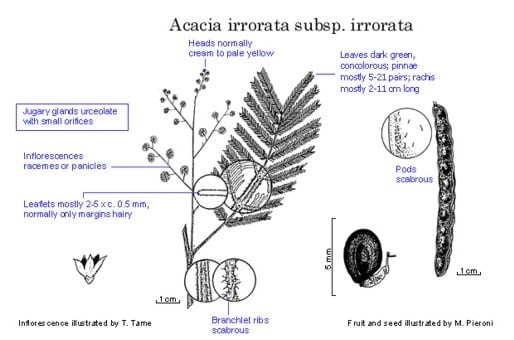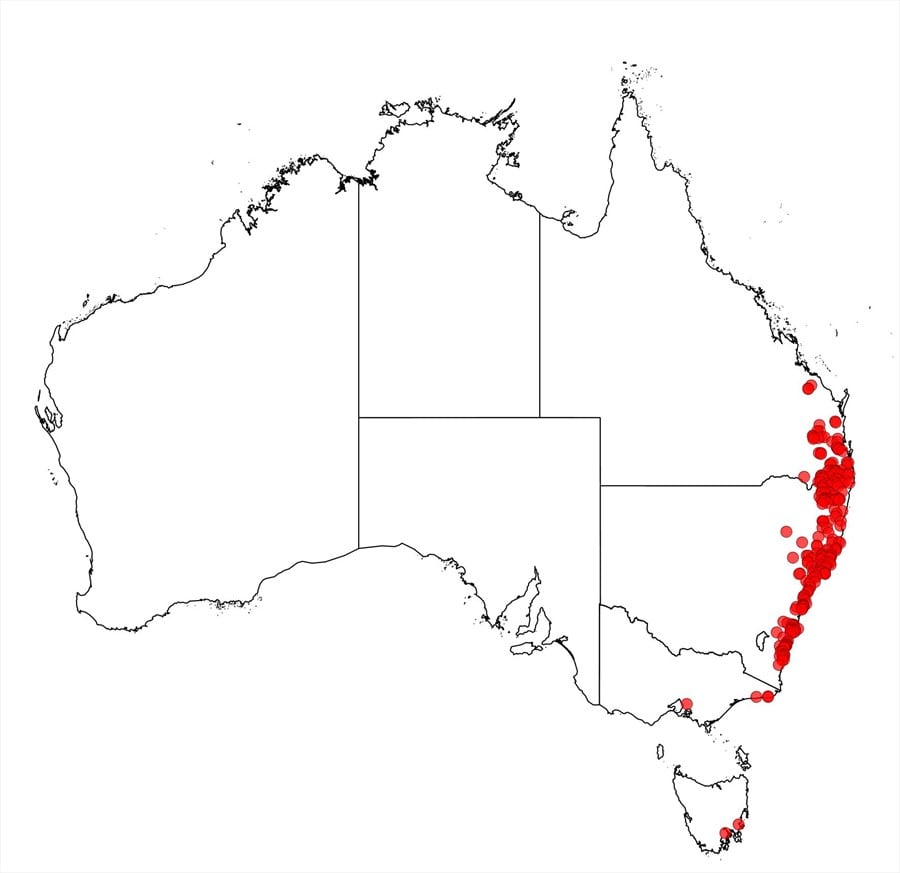Acacia irrorata Sieber ex Spreng. subsp. irrorata
WATTLE
Acacias of Australia
Family
Fabaceae
Distribution
Extends from Gympie, south-eastern Qld, through the coast and eastern region of N.S.W. (as far W as Gunnedah and S to Bermagui); rare in Vic. in East Gippsland, and probably introduced in Tas. where there are old records from the Hobart–Orford area.
Description
Tree to 12 m high. Bark of trunk smooth, becoming rough, dark grey, dark brown or black. Branchlets with tubercles on the ridges in juvenile and mature plants. Young foliage-tips golden, greenish yellow or rarely orange. Leaf petioles and rachises with fawn stiff hairs and brown or fawn round urceolate glands (with small orifices) at the uppermost 1 or rarely 2–4 pairs of pinnae and sometimes at lowest pair; pinnules white-ciliate, otherwise glabrous. Corolla dissected to 1/5–1/6 of its length. Pods scabrous, appressed-hairy at first.
Phenology
Flowers anytime of the year; fruits Sept.–Dec.
Habitat
Grows on rainforest margins, open forest, scrub-forest, in valleys or on hillsides, often in sandy or volcanic soils.
Specimens
Qld: Cunninghams Gap, 29 July 1988, D.A.Saladine & G.J.White (AD, CANB, MEL, NE, NSW); 1.6 km S of Wondai, M.D.Tindale s.n. (NSW52680). N.S.W.: 2.4 km E of Hwy 1 on Durras track, M.Evans 2776 (A, AD, CANB, K, L, MEL, NSW, PERTH); 6 km S of Bateman’s Bay, A.N.Rodd 4265 (BRI, MEL, NSW). Vic.: Croajingalong Natl Park, c. 4 km SW of Mt Everard, J.G.Eichler (MEL, NSW256002). Tas.: Mt Wellington, J.H.Maiden (NSW53105).
Notes
On the North Coast, N.S.W., A. irrorata subsp. irrorata is largely replaced by subsp. velutinella. The bark of subsp. irrorata is thin and the tannin content inferior to that of A. mearnsii.
FOA Reference
Data derived from Flora of Australia Volumes 11A (2001), 11B (2001) and 12 (1998), products of ABRS, ©Commonwealth of Australia
Author
M.D.Tindale, P.G.Kodela
This identification key and fact sheets are available as a mobile application:
URL: https://apps.lucidcentral.org/wattle/
© Copyright 2018. All rights reserved.









